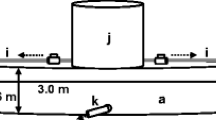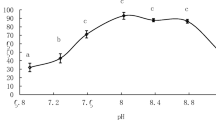Abstract
The brown shrimp,Farfantepenaeus aztecus, is the major component of the Gulf of Mexico shrimp fishery, and it is critical that we understand its environmental requirements. Brown shrimp spend a large portion of their post-larval (PL) and juvenile life within estuaries distributed along salinity gradients and yet our understanding of the salinity tolerance of various age groups is limited. A series of 48-hr bioassays were conducted in which various ages ofF. aztecus (PL-10, PL-13, PL-15, PL-17, PL-20, and PL-23) were acclimated from a salinity of 26‰ to 1‰, 2‰, 4‰, 8‰, 12‰, and 26‰ in order to determine their tolerance to these salinities. Finally, PL-80.F. aztecus were transferred directly from 25‰ to 2‰, 4‰, and 8‰ waters to study the effects of rapid salinity reductions on juvenile survival. Survival of 10-and 13-day-old PLs was significantly, different from the control (26‰) for all salinities tested. Survival of PL-15 shrimp and older was significantly lower than survival of the controls at 1‰ and 2‰ but similar to the control at all other salinities tested. A 4-wk growth trial was conducted with juvenile shrimp at 2‰, 4‰, 8‰, and 12‰. There was no significant difference in survival among treatments, although shrimp maintained at 8‰ and 12‰ grew significantlymore than shrimp maintained at 2‰ and 4‰. There was no growth difference between shrimp at the two low salinities or between shrimp at the two high salinities. Survival of juveniles transferred directly from 25‰ to various salinities were 100% at 25‰, 94.2% at 8‰, 67.3% at 4‰, and 63.5% at 2‰. These results suggest that PL-13 and younger brown shrimp would have a better chance of survival by delaying entry into estuaries susceptible to rapid salinity declines. The brown shrimp juveniles would, be more densely distributed in areas with salinities greater than 4‰ than in salinities less than 4‰. Although food availability, and bottom type also affect shrimp distribution survival and growth, salinity may also greatly affect the shrimp and its fishery.
Similar content being viewed by others
Literature Cited
Arreguin-Sanchez, F. andR. G. Castro-Melendez. 2000. On the interdependence of sequential fisheries: The brown shrimp,Farfantepenaeus aztecus, fisheries in the northwestern Gulf of Mexico.Crustaceana 73:333–343.
Baxter, K. N. 1963. Abundance of postlarval shrimp-an index of future shrimping success.Proceedings of the Gulf and Caribbean Fisheries Institute 15:79–87.
Benfield, M. C. andD. V. Aldrich. 1992. Attraction of postlarvalPenaeus aztecus Ives andP. setiferus (L.) (Crustacea: Decapoda: Penaeidae) to estuarine water in a laminar-flow choice chamber.Journal of Experimental Marine Biology and Ecology 156:39–52.
Bray, W. A., A. L. Lawrence, andJ. R. Leung.-Trujillo. 1994. The effect of salinity on growth and survival ofPenaeus vannamei, with observations on the interaction of IHHN virus and salinity.Aquaculture 122:133–146.
Gracia, A. 1991. Spawning stock-recruitment relationships of white shrimp in the Southwestern Gulf of Mexico.Transactions of the American Fisheries Society 120:519–527.
Holliday, M. C. and B. K. O'Bannon.. 1991. Fisheries of the United States. U.S. National Marine Fisheries Service Current Fishery Statistics 9000. Washington, D.C.
Howe, J. C. andR. K. Wallace. 2000. Relative abundance of postlarval and juvenile penaeid shrimps in submerged aquatic vegetation and emergent marsh habitats.Gulf of Mexico Science 18:130–137.
Howe, J. C., R. K. Wallace, andF. S. Rikard. 1999. Habitat Utilization by postlarval and juvenile penaeid shrimp in Mobile Bay, Alabama.Estuaries 22:971–979.
Hughes, D. A. 1972. Responses to salinity change as a tidal transport mechanism of pink shrimp,Penaeus duorarum Burkenroad.Biological Bulletin 136:43–53.
Kumlu, M. andD. A. Jones. 1995. Salinity tolerance of hatchery-reared postlarvae ofPenaeus indicus H. Milne Edwards, originating from India.Aquaculture 130:287–296.
Matthews T. R., W. W. Schroeder, andD. E. Stearns. 1991. Endogenous rhythm, light and salinity effects on postlarval brown shrimpPenaeus aztecus Ives recruitment to estuaries.Journal of Experimental Marine Biology and Ecology 154:177–189.
McGraw, W. J., D. A. Davis, D. Teichert-Coddington, andD. B. Rouse. 2002. Acclimation ofLitopenaeus vannamei postlarvae to low salinity: Influence of age, salinity endpoint, and rate of salinity reduction.Journal of the World Aquaculture Society 33:78–84.
McTigue, T. A. andR. J. Zimmerman. 1991. Carnivory versus herbivory in juvenilePenaeus setiferus (Linnaeus) andPenaeus aztecus (Ives).Journal of Experimental Marine Biology and Ecology 151:1–16.
McTigue, T. A. andR. J. Zimmerman. 1998. The use of infauna by juvenilePenaeus aztecus Ives andPenaeus setiferus (Linnaeus).Estuaries 21:160–175.
Nance, J. M., E. X. Martinez, andE. F. Klima. 1994. Feasibility of improving the economic return from the Gulf of Mexico brown shrimp fishery.North American Journal of Fisheries Management 14:522–536.
Rodgers, L. J. 2001. Assessment of oyster habitat in Mobile Bay, Alabama using index modeling, geographic information systems and computational fluid, dynamic modeling. Ph.D. Dissertation, Auburn University, Auburn, Alabama.
Rogers, B. D., R. F. Shaw, W. H. Herke, andR. H. Blanchet. 1993. Recruitment of postlarval and juvenile brown shrimp (Penaeus aztecus Ives) from offshore to estuarine waters of the northwestern Gulf of Mexico.Estuarine, Coastal and Shelf Science 36:377–394.
Rosas, C., L. Ocampo, G. Gaxiola, A. Sanchez, andL. A. Soto. 1999. Effect of salinity on survival, growth, and oxygen consumption of postlarvae (PL10–PL21) ofLitopenaeus setiferus.Journal of Crustacean Biology 19:244–251.
Rozas, L. P. andR. J. Zimmerman. 2000. Small-scale patterns of nekton use among marsh and adjacent shallow nonvegetated areas of the Galveston Bay estuary, Texas (USA).Marine Ecology Progress Series 193:217–239.
Simmons, E. G. 1957. An ecological survey of the upper Laguna Madre of Texas.Publication of the Institute of Marine Science of the University of Texas 4:156–200.
Tsuzuki, M. Y., R. O. Cavalli, andA. Bianchini. 2000. The effects of temperature, age, and acclimation to salinity on the survival ofFarfantepenaeus paulensis postlarvae.Journal of the World Aquaculture Society 31:459–468.
Weinstein, M. P. 1979. Shallow marsh habitats as primary nurseries for fishes and shellfish, Cape Fear River, North Carolina.Fishery Bulletin, U.S. 77:339–357.
Wenner, E. L. andH. R. Beatiy. 1993. Utilization of shallow estuarine habitats in South Carolina, U.S.A., by postlarval and juvenile stages ofPenaeus spp. (Decapoda: Penaeidae).Journal of Crustacean Biology 13:280–295.
Zein-Eldin, Z. P. 1963. Effect of salinity on growth of postlarval penaeid shrimp.Biological Bulletin 125:188–196.
Zein-Eldin, Z. P. andD. V. Aldrich. 1965. Growth and survival of postlarvalPenaeus aztecus under controlled conditions of temperature and salinity.Biological Bulletin 129:199–216.
Zein-Eldin, Z. P. and {Gng. W.}Griffith.. 1969. An appraisal of the effects of salinity and temperature on growth and survival of postlarval penaeids.FAO Fisheries Report 57:1015–1026.
Zein-Eldin, Z. P. andM. L. Renaud. 1986. Inshore environmental effects on brown shrimp,Penaeus aztecus, and white shrimp,P. setiferus, populations in coastal waters particularly of Texas.Marine Fisheries Review 48:9–19.
Zimmerman, R. J., T. J. Minello, M. C. Castiglione andD. L. Smith. 1990. Utilization of marsh and associated habitats along a salinity gradient in Galveston Bay.NOAA Technical Memorandum NMFS-SEFC 250:1–51.
Author information
Authors and Affiliations
Corresponding author
Rights and permissions
About this article
Cite this article
Saoud, I.P., Davis, D.A. Salinity tolerance of brown shrimpFarfantepenaeus aztecus as it relates to postlarval and juvenile survival, distribution, and growth in estuaries. Estuaries 26, 970–974 (2003). https://doi.org/10.1007/BF02803355
Received:
Revised:
Accepted:
Issue Date:
DOI: https://doi.org/10.1007/BF02803355




